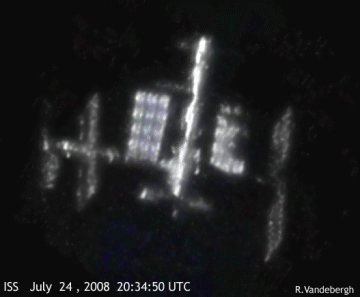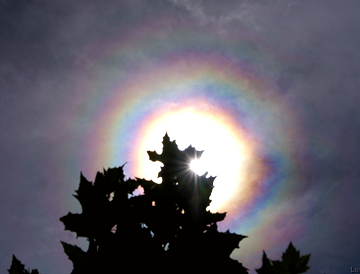| PLASMA BULLETS SPARK NORTHERN LIGHTS: Researchers have discovered what powers brilliant outbursts of Northern Lights: gigantic plasma bullets launched toward Earth by explosions 1/3rd of the way to the Moon. Get the full story from Science@NASA. SPACE STATION RADIATORS: Last night, the International Space Station flew directly over the Netherlands where amateur astronomer Ralf Vandebergh was ready with his 10-inch telescope. "I've waited years for this one--a perfect 90o pass!" says Vandebergh. "The station was at its closest distance as it passed directly overhead." Guiding the optics by hand, he centered the spaceship in his viewfinder and snapped this picture: 
The close-up photo shows the space station's gleaming backbone, its solar wings, science labs and docked cargo ships--but best of all, says Vandebergh, "it gave a very nice view of the station's fully-deployed thermal radiators." When the marvels of the ISS are discussed, radiators are seldom mentioned, yet they are one of the space station's truly critical systems. Indeed, the crew couldn't live without them. Because the space station is superbly insulated against the cold of space, heat generated by people and electronics inside the station has a hard time getting out. Left unchecked, the buildup of heat would literally cook the contents of the ISS. Radiators provide relief. The cooling system works much like a car radiator except that it uses 99.9% pure ammonia instead of water, which would freeze in pipes outside the space station. The silvery radiators are also good reflectors, adding significantly to the brightness of the space station and making it a lovely sight in the night sky. See for yourself. RINGS AROUND THE SUN: The next time you see a cloud approaching the sun, duck into the shadows and watch what happens. Monika Landy-Gyebnar of Veszprem, Hungary, followed these instructions, and here is her report: "Coming home from work I saw a nice altocumulus cloud drifting toward the sun. So I only had to find something to shade the sun and wait.... Soon, four rings appeared; they had wonderfully bright colors and completely encircled the sun." A 1/4000 second exposure at ISO 100 produced this image: 
This rainbow-colored apparition is not a rainbow, but "a corona," says atmospheric optics expert Les Cowley. "Coronas are much smaller than rainbows and are hard to see unless you shield the sun. They are the diffraction pattern produced when light waves bounce off small cloud droplets. One ring is usual, four are a rarity!" Other things you can see from the shadows: iridescence, ice halos and sundogs. The view is great and, on a hot summer day, it's a cool place to be. more images: from Kyle Rohr at Crater Lake, Oregon; from Emma Herranen of Tampere, Finland; from Bob King of Duluth, Minnesota; from Yasmin Angelique Walter of Dreieich, Germany; from Austin Taylor of Scalloway, Shetland Islands, UK; from Doug Zubenel of Johnson Co., Kansas
2008 Noctilucent Cloud Gallery
[Strange Clouds] [Sky Cameras] | 
